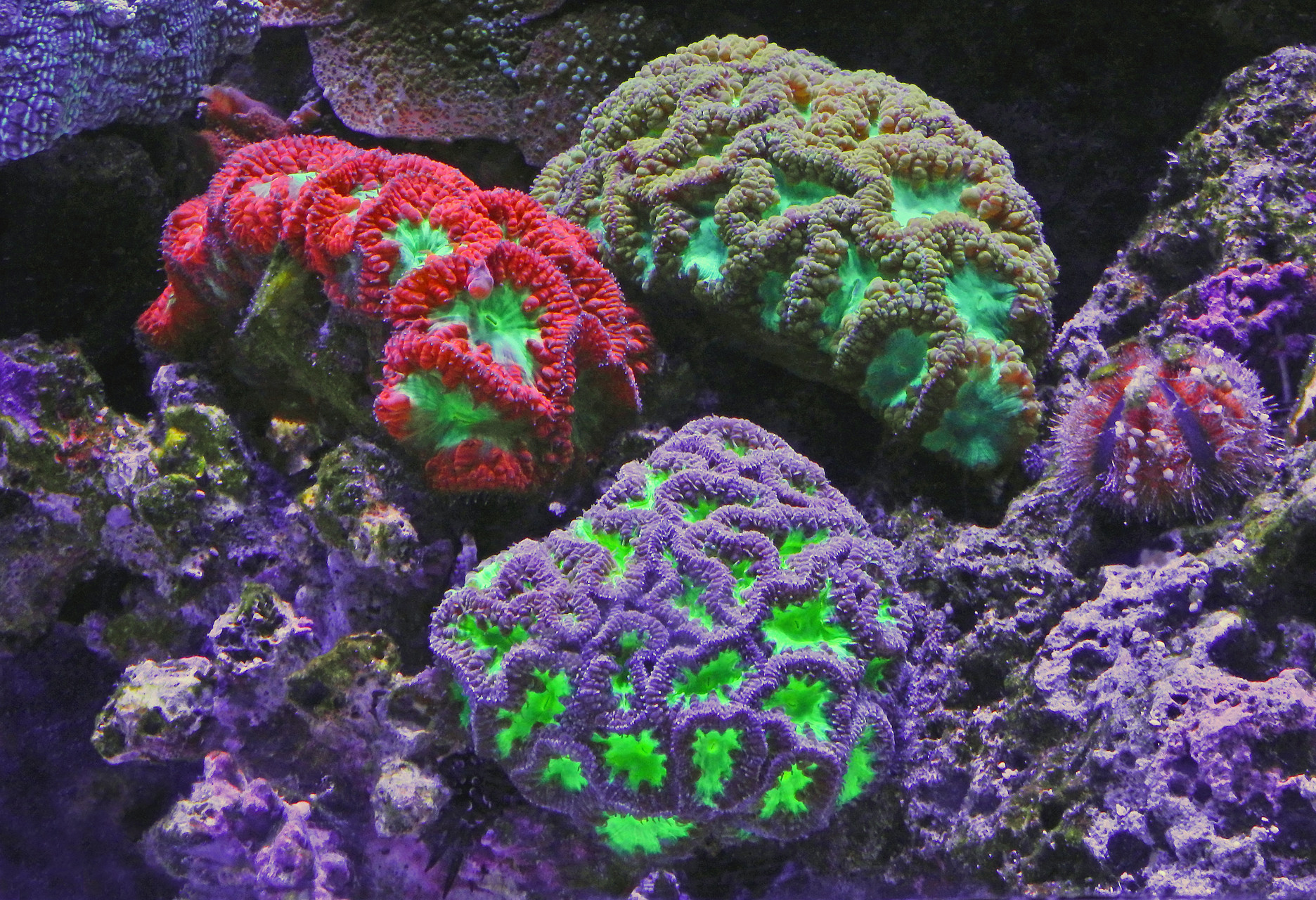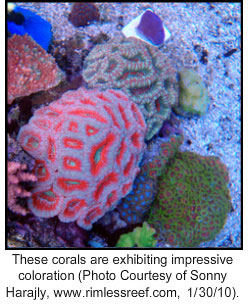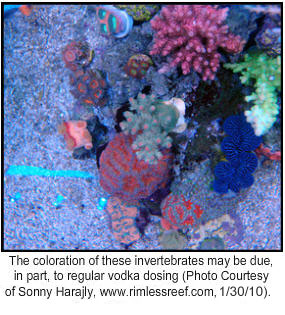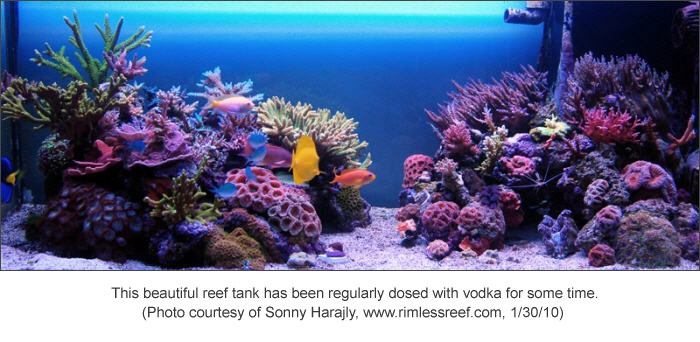Gimme a Vodka, on the Live Rocks, with a Splash of Heavy Skimming

Many hobbyists are aware of the...wellopinionated nature of marine husbandry experts. And there is nothing we like better than a juicy controversy to sink our teeth into. Something likesaydosing a reef tank with vodka.

If you are not already familiar with this topic, let me bring you quickly up to speed. Some people believe that carbon availability may limit the growth of beneficial bacteria in a marine aquarium. Through the addition of an external carbon source, such as vodka, the bacterial colonies are thought to be enlarged (sugar and vinegar have also been used in the same manner). As a result, the rates at which nitrate and phosphate are sequestered within living organisms are theoretically increased. Once locked away within living organisms (bacteria) and biotic sludge, heavy protein skimming removes the material from the system. Advocates of the process claim that their tank water is crystal clear, their nitrate and phosphate levels are immeasurable, and their coral growth and coloration is better. They also claim a significant decrease in the growth of nuisance algae. Detractors, on the other hand, point out that current practices have already achieved the same water quality without the use of vodka. The combined utilization of Deep Sand Beds (DSB), shallow sand beds, live rock, algal refugiums, and protein skimming, have already allowed novice aquarists to do things even experts thought extraordinary just 20 years ago.
The idea of using ethanol (in the form of vodka) to boost bacterial colonization is not new. It appears to have a cyclical lifespan, which brings it in and out of favor with aquarists. At the moment, however, the idea seems to be going through a boom period. Having never tried dosing vodka myself, I am afraid I cannot claim to be either in favor or opposed to the idea. I would rather examine the subject from a more objective position by reviewing the basic principles, such as how carbon might limit bacterial growth, and whether scientific evidence corroborates anecdotal stories.

When examining phytoplankton, usually diatoms, scientists have found that most exhibit very particular molar proportions of carbon (C), nitrogen (N), and phosphorous (P). This C:N:P proportion, 106:16:1, is known as the Redfield ratio, or alternately, the Redfield stoichiometry. Though the Redfield ratio is specific to phytoplankton, it coincides very strongly to the average C:N:P proportion in seawater. Whether marine bacteria contain a similar ratio depends strongly on the specific conditions under which those bacteria are cultured. Scientific studies have shown that the ratio can vary greatly in both directions. Regardless of the absolute number, however, it can be assumed that if one or two of the constituents begin to accumulate in excess, the availability of the other has been somehow limited. In the aquarium, a build-up of nitrate or phosphate is therefore assumed to be a function of carbon limitation. Astute aquarists will observe that carbon levels may appear to be adequate, even while limiting the bacterial growth. This apparent discontinuity occurs because the carbon available for assimilation by corals is refractory, or less reactive. To put it another way, the bacteria require carbon to come in a more usable form than do corals.
By increasing the carbon available to bacteria during denitrification, it is generally thought that the vodka increases the carbon in the C:N:P proportion. The result should be an increased capacity to process nitrates and phosphates within the system, as evidenced by healthier animals and clearer water. The one catch is that the system will produce an excess of biogenous material, which will need manual removal. This is where the protein skimmer becomes mandatory. Users of the vodka method report a significant increase in both the volume and the viscosity of the skimmate they remove. This skimmate is likely comprised of the bacteria themselves, as well as their proteinaceous secretions. The good news is that the skimmate is also heavily laden with nitrates and phosphates, which are exactly what need removal. The other benefit of skimming is gas exchange. Dosing vodka can act to depress dissolved oxygen levels, to the detriment of livestock. The protein skimming process helps to re-establish the proper oxygen concentrations (a process some aquarists augment with ozonators).
On the surface, vodka seems like a slam dunk solution to poor water quality. As with anything though, the idea is not without its drawbacks. First, without adequate protein skimming, a slimy film can develop on live rock and other substrates. Second, the tank water can develop a temporary cloudiness of debatable origin; it could be a bacterial bloom or carbonate precipitation, but a definitive scientific explanation appears not to exist. Invertebrates appear to be relatively unaffected, but fish may succumb to oxygen deprivation if their gills become inundated with gunk. Third, those using a DSB may find results of the vodka to be delayed or negligible. In fact, the cloudy blooms seen in some systems may be due to overdosing caused by DSB users, trying to force results with increased dosages. Fourth, alkalinity needs to be more tightly controlled so that it does not elevate beyond levels normal to seawater (7-8 dKH). SPS corals may suffer tissue damage associated with higher-than-normal alkalinity. Fifth, when regular water changes are not employed, organic build-ups can lead to a yellowing of the tank water.
In spite of the numerous drawbacks, many aquarists are ecstatic with the results of their vodka regime. They are typically emphatic that vodka is providing them great results. In point of fact, there is really no evidence to rebuttal their assertions. Unfortunately, therein lies the problem. Strict scientific studies have not been conducted regarding this subject, as far as I can tell. There are loose attempts to quantify results in un-replicated, non-parametric studies. However, what is lacking is a strong study which utilizes the accepted principals of science (e.g. hypothesis, replication, control, parametric statistical analysis, etc). Though there may be some credibility to the vodka theory, it needs to be proven more conclusively.
What I find interesting about the vodka debate is not the question about whether it works, but rather whether it is necessary. The real goal is to simply increase denitrification and other avenues of export for nitrates and phosphates. While the idea that denitrification must occur under anoxic conditions has been perpetuated, there is ample scientific evidence which contradicts this notion. Denitrifying bacteria exist pretty much everywhere in the ocean, including on the surfaces of corals and sponges. From this fact, we can assume that much more denitrification is happening in an aquarium than first assumed. On some level, the debate becomes more about the needs of a particular system, rather than whether vodka gets the job done. If you are running a well-maintained tank with excellent water quality and good coral color and growth, you probably do not need to change anything. Conversely, if all your efforts to keep the system thriving have failed because it is not clean enough, you may find that vodka helps you reach that level of clean you have been seeking. Also, if all goes well, you may find that the systems bioload can be increased somewhat, if its waste handling capacity is improved.
If you decide you want to go the vodka route, I would caution you to do so with extreme care. Be sure that you are running an oversized protein skimmer with a large collection cup. I have opted not to include dosages here because I could not find a well-substantiated protocol. However, there does seem to be some consensus on the maximum dosage, which is about 5-10 ml per 250 gallons per day. It is also generally agreed that erring on the side of underdosing, especially initially, is far better than adding too much vodka. In general, I always recommend performing weekly or bi-weekly water changes of 10 to 20%, respectively. It seems very reasonable to assume that such regular water changes should be maintained if vodka supplementation is instituted.
If there is anything experience in this field has taught me, it is that no opinion should be discounted entirely. Nor should any opinion be considered infallible, for that matter. Here is an interesting thought, from one major vodka opponent, Eric Borneman (2004), Why vodka? Why not sugar? And if sugar, why not more photosynthetic organisms to produce the sugar? And why not more corals to produce polysaccharide rich mucus? Would adding more corals reduce nitrate? Actually, they would and they do. A long time ago, when Steve Tyree had promoted the use of sponges for natural filtration, I suggested corals would accomplish the same purpose. Clearly, Bornemans opinion is that vodka does a job that can be done by inhabitants that are already in situ. I do not necessarily disagree, but I also believe in trying new things and generating my own results and observations. I cannot say with absolute certainty that vodka does or does not have a place within the world of marine husbandry, but I will leave you with one last thought on the subject: If your tank looks beautiful, does it matter how you got it there?
